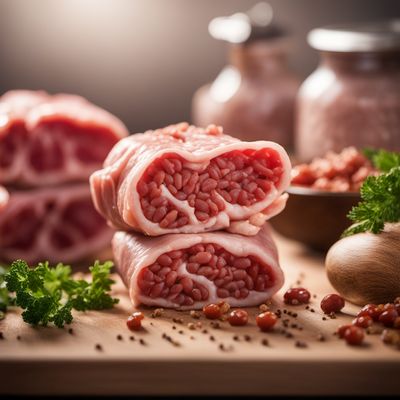
Ingredient
Bovine and pig fresh meat
The Butcher's Bounty: Exploring Fresh Bovine and Pig Meat
Bovine and pig fresh meat, derived from cattle and pigs, respectively, are prized for their tenderness, juiciness, and distinct flavors. Bovine meat, such as beef, can vary in marbling, which contributes to its richness and tenderness. Pig meat, including pork, offers a balance of lean cuts and fattier portions, allowing for a variety of cooking methods and flavor profiles.
Origins and history
The consumption of bovine and pig meat dates back thousands of years, with evidence of domestication and utilization by ancient civilizations. Cattle and pigs were valued for their meat, milk, and other byproducts, making them integral to the development of agricultural societies. Today, beef and pork are staples in cuisines worldwide, with each culture showcasing unique preparations and cooking techniques.
Nutritional information
Bovine and pig fresh meat are excellent sources of high-quality protein, essential amino acids, vitamins, and minerals. They provide important nutrients like iron, zinc, and B vitamins, contributing to overall health and well-being. However, it is important to consume these meats in moderation as part of a balanced diet.
Allergens
May cause allergic reactions in individuals with specific meat allergies or sensitivities.
How to select
When selecting bovine and pig fresh meat, look for cuts that are bright red in color, with a firm texture and minimal visible fat. The meat should have a fresh, clean smell, without any off-putting odors. For beef, marbling is an indicator of tenderness and flavor. For pork, choose cuts with a pinkish hue and a good ratio of lean meat to fat.
Storage recommendations
To maintain the freshness and quality of bovine and pig fresh meat, it is crucial to store them properly. Refrigerate the meat at a temperature below 40°F (4°C) to inhibit bacterial growth. For longer storage, freezing is recommended. Wrap the meat tightly in plastic wrap or place it in airtight containers to prevent freezer burn. Use frozen meat within a few months for optimal taste and texture.
How to produce
Bovine and pig fresh meat is produced through the rearing and slaughtering of cattle and pigs in controlled environments. This process requires specialized knowledge and adherence to strict hygiene and safety standards. It is typically carried out by professional butchers or in commercial meat processing facilities.
Preparation tips
Before cooking bovine and pig fresh meat, it is essential to handle it safely and follow proper cooking techniques. Ensure the meat is thoroughly thawed if frozen, and bring it to room temperature before cooking to promote even cooking. Season the meat with salt and pepper or other desired spices, and cook using suitable methods such as grilling, roasting, or pan-searing. Rest the cooked meat before slicing to retain its juices and tenderness.
Culinary uses
Bovine and pig fresh meat are incredibly versatile and can be used in a wide range of dishes. Beef can be grilled to perfection for steaks, slow-cooked for stews, or ground for burgers. Pork can be roasted for succulent pork chops, braised for tender pulled pork, or sliced thin for stir-fries. These meats are integral to various cuisines, including American, European, and Asian.
